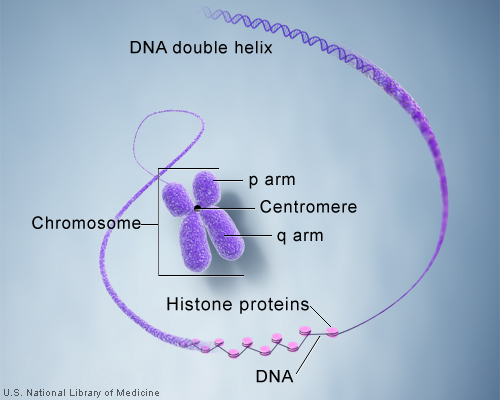Chromosomes are the basic building blocks of life where the entire genome of an organism is essentially organized and stored in the form of DNA (deoxyribonucleic acid) which is present inside every cell making up that organism. A chromosome is a single chain of DNA that is coiled and super coiled to form dense thread-like pieces. The term chromosome is derived from the Greek words "chroma" or color and "some" or body and is so named because chromosomes have the ability to be stained with dyes.

DNA and histone proteins are packaged into structures called chromosomes. Image Credit: U.S. National Library of Medicine
DNA is the genetic instruction book for enabling the production of proteins and cell processes that are essential to life and inherited from generation to generation. Every piece of DNA is composed of gene sequences containing instructions for each cell's development, reproduction and ultimately death. Each of the DNA chains within chromosomes may contain anywhere between 10,000 to 1,000,000,000 nucleotides.
The DNA is broken up into single stranded polynucleotide chains to expose gene sequences that can be copied into messengerRNA (mRNA, ribonucleic acid). This mRNA has four nucleotide bases arranged in different combinations of three and is similar to DNA. Ribosomes read these three-based nucleotide sequences and translates it to form the amino acid sequence of a protein Each three-based nucleotide codes for one of 20 amino acids, also known of as the building blocks of proteins. First, the amino acids form a long chain called the polypeptide chain. This chain then undergoes conformational and structural changes, folding and refolding over itself until the final complex structure of a protein is achieved. Chromosomes also contain DNA-bound proteins or histones that consolidate and stabilize the DNA and regulate its functions.
DNA and histone proteins are packaged into structures called chromosomes.
A chromosome may be circular or linear in shape, with nucleated or eukaryotic cells having linear chromosomes, and prokaryotic cells usually containing circular chromosomes. Chromosomes may also exist outside of the nucleus in eukaryotic cells, within the mitochondria or the "power houses" of cells.
Chromosomes may have condensed DNA organized around histone proteins to form chromatin. Chromatin allows long chains of DNA to be fitted within a cell nucleus. On cell division, the chromosomes form dense small thread-like structures that must be replicated before being equally divided between two daughter cells, to ensure each has an equal number of chromosomes. When body cells divide (mitosis), two copies of the 23 chromosomes are passed onto each daughter cell, giving them both a complete set of 46 chromosomes. When gametes (egg or sperm cells) divide (meiosis), only half the amount of chromosomes is passed onto daughter cells, as these daughter gametes will only form a cell with a complete set of chromosomes on fusion with another gamete during fertilization, after which the resulting zygote will have 23 pairs of chromosomes with half from each parent.
Further Reading
Last Updated: Feb 26, 2019